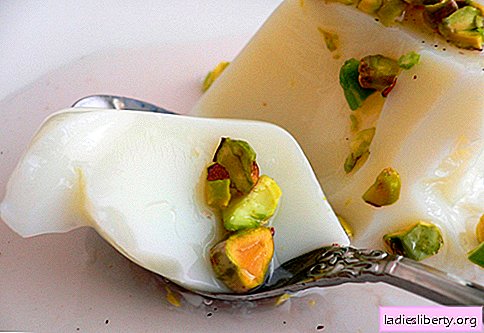
Phlox - flowers from childhood that have not lost popularity. Today, many varieties that I would like to see in my garden are bred, therefore, it is simply necessary to know the main methods of cultivating this culture.
Features of phlox reproduction in spring
In spring, phlox is propagated by dividing an adult bush and cuttings. Both methods maintain the varietal quality of the plant, which is especially important for gardeners.
Bush division
It is better to separate adult phlox bushes in early spring, while the shoots are not too large. Suitable time is April - May. This method of reproduction makes it possible to admire flowering in the fall.
Landing Instructions:
1. Completely dig out the bush, shake the rhizome from excess soil or rinse in a bucket of water.
2. With a sharp knife, divide the roots into several divisions, so that each has growth buds. Sprinkle places of slices with crushed coal.
3. Too long roots shorten by a third, old, dry and damaged cut.
4. Delenki land immediately in a permanent place.
The younger the uterine bush, the better it is divided. The roots of older plants are more fragile, easily injured during transplantation.
Advice! If it is not possible to immediately plant the phlox, then the rhizome should be wrapped with wet sphagnum moss and placed in a paper bag. Store no more than two days.
Spring cuttings
During spring phlox propagation, the survival rate of planting material is almost 100%. The best time to breed is May. Cuttings are cut from a three-year bush, and more than 50% of the shoots must be left.
Cherenkovka order:
1. Cut the cuttings at the very base of the bush with a piece of cloth "heel". The length of the shoot is from 5 to 10 cm.
2. Plant branches at a distance of 5 - 7 cm in loose fertile soil. The depth of the cuttings is two buds.
3. Planting is well watered and pritenit.
In hot weather, the cuttings are watered often, the soil should always be moist. It takes more than a month to root. When new shoots grow, the young bush should be fertilized with a mineral complex at least twice. The interval between feeding is two weeks. The first three months after rooting, the bush forms the root system, and begins to bloom in the fourth. Full-fledged varietal flowering can be seen in the third year of cultivation.
How to propagate varietal phlox in the summer
In summer, phlox can be planted with green leafy cuttings. Leaves are cut only from a healthy plant along with a “heel”. Sheet length not less than 8 - 10 cm.
Rooting cuttings is better in special boxes filled with loose soil. A layer of sand 2–3 cm thick is poured on top. The leaf stalk is immersed in the soil at an angle so that the lower part does not lie on the ground. Watered only with warm water and always sprayed. By autumn, a young shoot will grow from the leaf. They grow it on a special garden bed. Next fall, they land on a permanent place.
Instructions for propagating phlox layering
In autumn, it is very simple to propagate phlox by layering.
1. At the end of summer, to high up the bush with fertile soil, water abundantly.
2. Maintain soil moisture by regularly watering the bush.
3. In mid-October, plant shoots with young roots in a permanent place.
Blooming phlox will begin next season.
Rooting in this way takes about 1.5 months, therefore, in regions with a short summer, the work time is shifted. A young bush should be transplanted to a permanent place no later than the beginning of September.
How to save and propagate a dying phlox bush
There are times when your favorite flowers are sick and cannot be cured - the entire ground part is affected, the roots are also partially damaged. You can save a dying plant. There is a little-known method of breeding phlox - root cuttings. The procedure is complex, success depends on the skills of the gardener.
Step-by-step instructions for planting root cuttings:
1. Dig up the remains of a bush with rhizome. For breeding, select the juiciest and thickest areas.
2. Divide the roots into parts so that each is no more than 5 cm and has several filiform roots.
3. Plant the remnants of the roots in a box with fertile soil, add threadlike roots, leave thick ones on the surface of the soil.
4. Fill the roots with a layer of sand 5 cm, water well.
5. Place the container in a dark place where the temperature is maintained at 13-15 ° C.
6. After 14 days, transfer the box to a room with a temperature of 18 - 20 ° C. This will be the impetus for the growth of young shoots.
When the first sprouts hatch, place the boxes in a bright place, avoiding direct sunlight. In mid-May, plant sprouts in the school. Previously, the seedlings are tempered - they briefly take it out to the street. A year later, young bushes are transplanted to a permanent place in the garden.
This method can be used both in spring and autumn. If propagation in this way is done at the end of the season, then the roots are placed in a box, as described above, and cleaned in the basement until the end of winter. In early March, they take it out and put it in a warm room, water it abundantly. When sprouts appear, they are gradually accustomed to sunlight and fresh air. Landing on the flowerbed is carried out at the end of May.
Tips and advice from experienced gardeners on the reproduction of phlox
Rooting phlox depends on many factors that need to be considered:
• cuttings are harvested in the evening or in rainy weather;
• before planting, they are stored in a damp cloth;
• before planting, the shoots are kept in a growth stimulator for at least 10 hours;
• The first peduncles are removed.
If you adhere to these rules, then the reproduction of phlox does not seem difficult. The main thing is to remove the first flowers so that the plant puts forth all its forces on the formation of roots.
Important! Never try to plant phlox seeds. This lesson is useless. Varietal qualities of flowers are not preserved, and it is difficult to germinate seeds.











